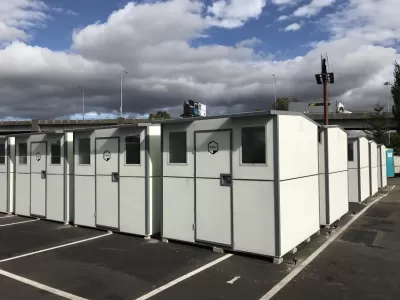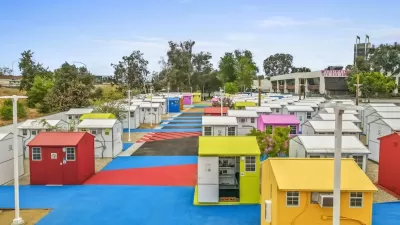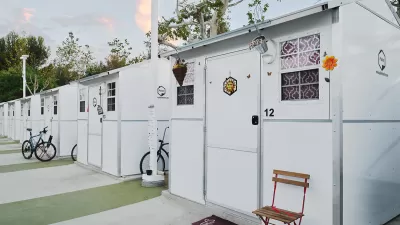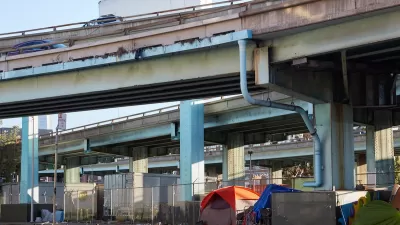'Tiny home villages' were touted as a quick, if temporary, solution to California's housing crisis, but a series of fires is raising concern about their safety.

A recent fire in a 'tiny home village' for unhoused people in Oakland is prompting questions about the safety and sustainability of these projects as a temporary stopgap in California's homelessness crisis, writes Alissa Walker in Curbed. "The structures, made by a Seattle-area company called Pallet, are currently being used as shelter for formerly unhoused residents in at least 70 villages in the U.S., according to a representative for the company."
The Oakland incident adds to a list of other fires in Pallet-built developments: "In October 2020, four Pallet shelters burned down and two were badly damaged in the Los Guilicos Village in Santa Rosa, California, when a wildfire encroached on the 60-shelter property. In December 2020, 20 Pallet shelters burned down in the Ramsey Street Village in Banning, California, displacing 40 people." The company later made changes in the materials it uses, though it denied that the changes were related to fire protection.
"Pallet’s shelters are equipped with smoke detectors, CO monitors, fire extinguishers, and an emergency exit panel, the company’s spokesperson Brandon Bills says." But according to fire marshall Lauren Andrade, the small size of the units (which, in some cases, house two residents each) is a major concern. "If it’s packed to the top, that will put out a lot of BTUs and spread quicker," says Andrade in the article.
Walker notes that "In California, where cities are doubling down on the criminalization of homelessness without creating enough permanent units for the unhoused, the tiny-home fix is hardly sustainable." The dubious safety and long-term viability of tiny home villages highlights the need for other, more long-term options for supportive housing.
FULL STORY: Tiny-Home Fires Raise Bigger Questions About Housing for Homeless

Study: Maui’s Plan to Convert Vacation Rentals to Long-Term Housing Could Cause Nearly $1 Billion Economic Loss
The plan would reduce visitor accommodation by 25,% resulting in 1,900 jobs lost.

North Texas Transit Leaders Tout Benefits of TOD for Growing Region
At a summit focused on transit-oriented development, policymakers discussed how North Texas’ expanded light rail system can serve as a tool for economic growth.

Why Should We Subsidize Public Transportation?
Many public transit agencies face financial stress due to rising costs, declining fare revenue, and declining subsidies. Transit advocates must provide a strong business case for increasing public transit funding.

How to Make US Trains Faster
Changes to boarding platforms and a switch to electric trains could improve U.S. passenger rail service without the added cost of high-speed rail.

Columbia’s Revitalized ‘Loop’ Is a Hub for Local Entrepreneurs
A focus on small businesses is helping a commercial corridor in Columbia, Missouri thrive.

Invasive Insect Threatens Minnesota’s Ash Forests
The Emerald Ash Borer is a rapidly spreading invasive pest threatening Minnesota’s ash trees, and homeowners are encouraged to plant diverse replacement species, avoid moving ash firewood, and monitor for signs of infestation.
Urban Design for Planners 1: Software Tools
This six-course series explores essential urban design concepts using open source software and equips planners with the tools they need to participate fully in the urban design process.
Planning for Universal Design
Learn the tools for implementing Universal Design in planning regulations.
City of Santa Clarita
Ascent Environmental
Institute for Housing and Urban Development Studies (IHS)
City of Grandview
Harvard GSD Executive Education
Toledo-Lucas County Plan Commissions
Salt Lake City
NYU Wagner Graduate School of Public Service





























